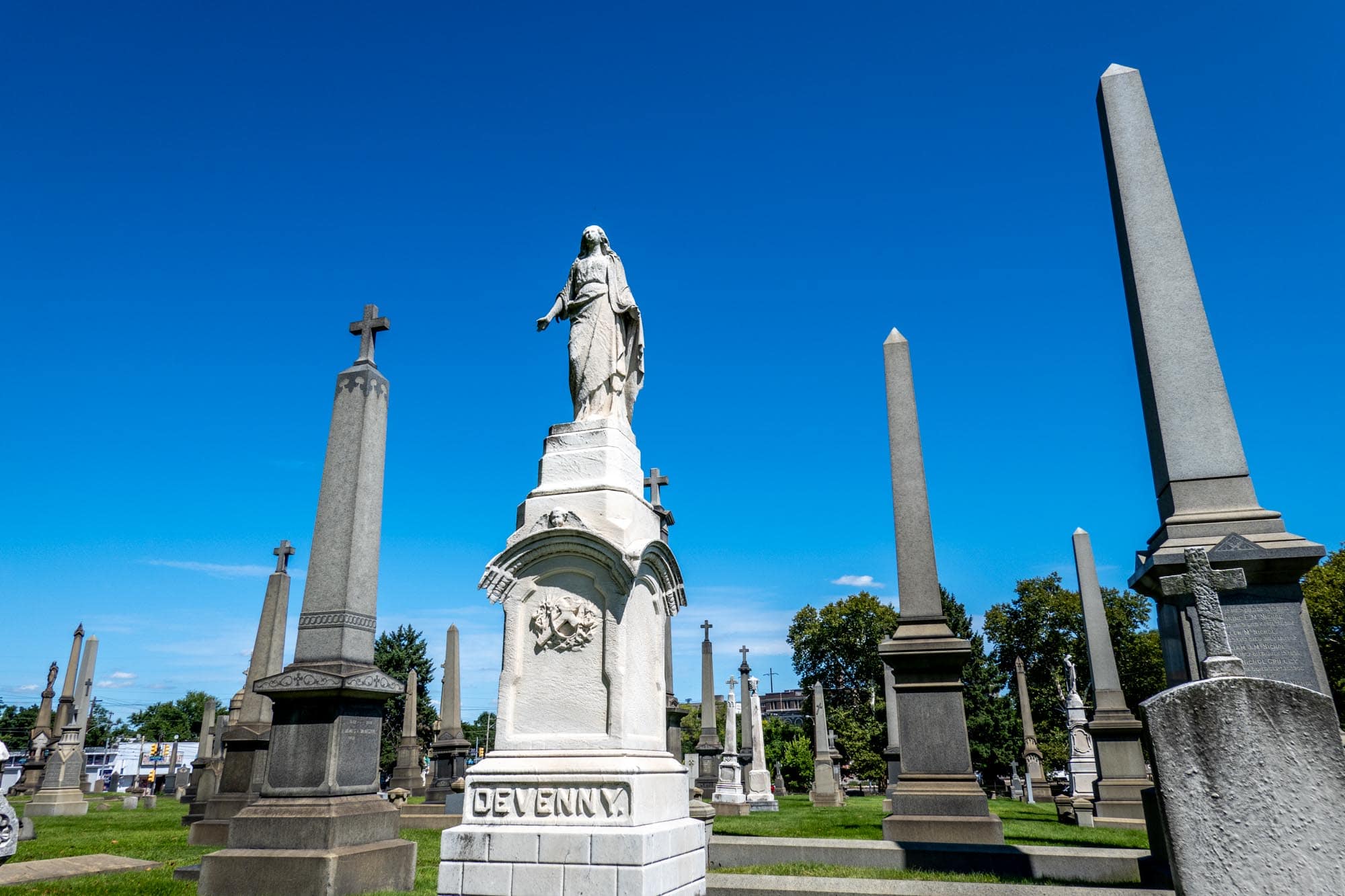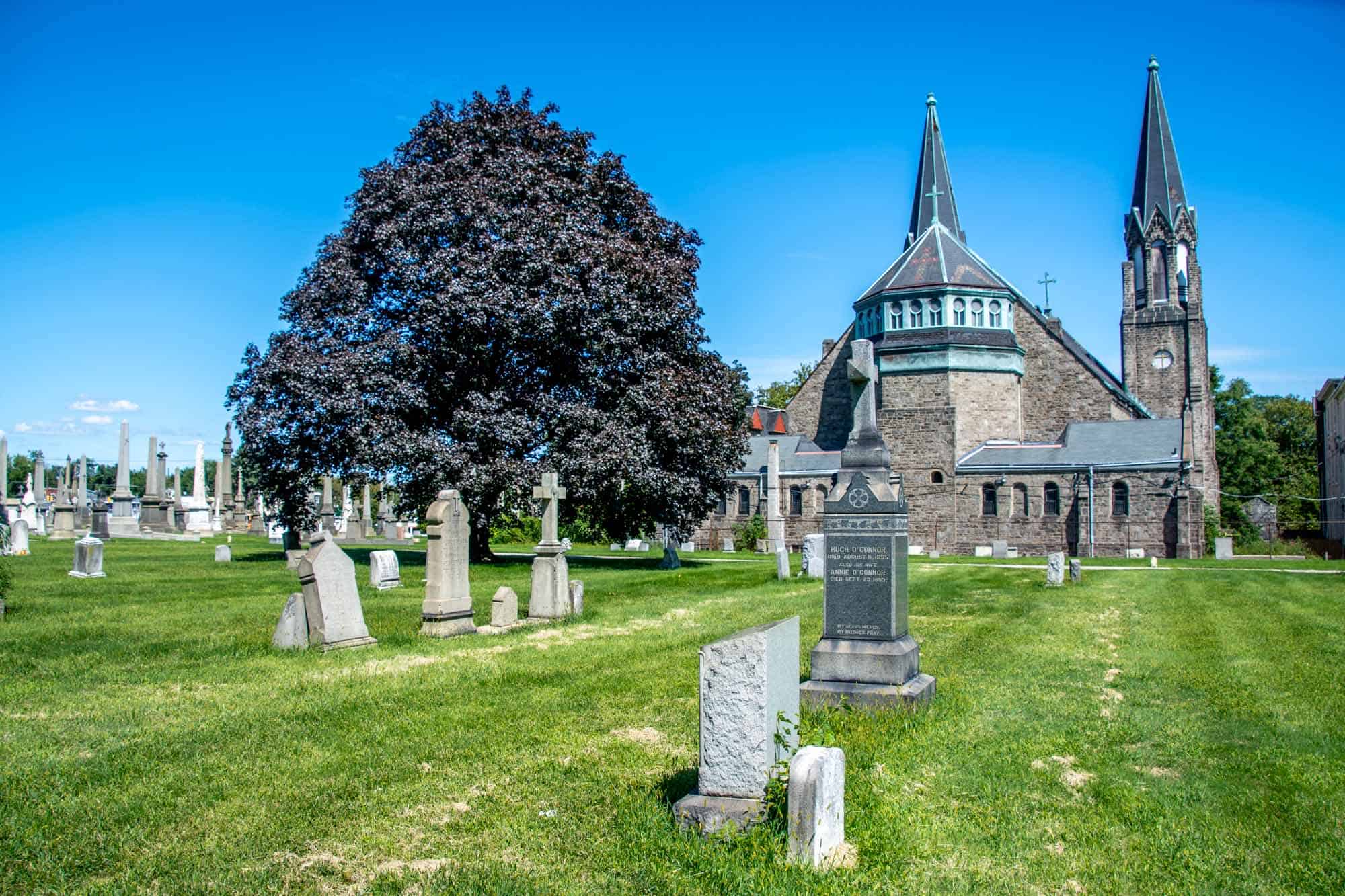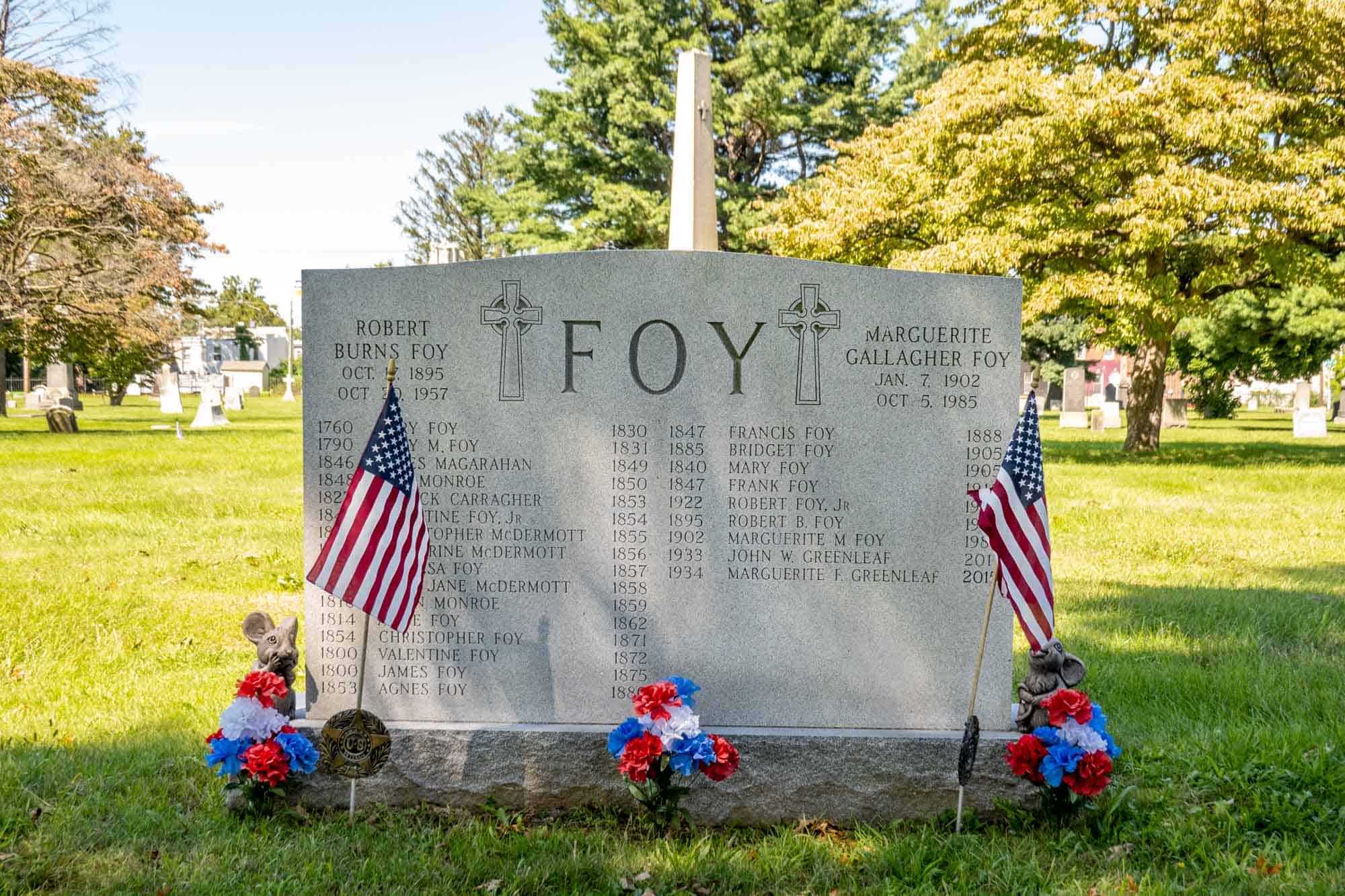While many people in Philadelphia have never heard of the Old Cathedral Cemetery, it is one of the more interesting burial grounds in the city. Located in the exact center of West Philadelphia, this cemetery tells the story of the city’s evolution and growth.
Despite being located just feet from the busy intersection of Lancaster Avenue and West Girard Avenue, the cemetery feels worlds apart. It is a quiet, peaceful place of beauty and reflection in the city.
History

Perhaps more than any other cemetery in the city, the Cathedral Cemetery in Philadelphia tells the story of immigration’s impact on the city. That incredible history is literally etched in stone.
The Old Cathedral Cemetery is the oldest catholic burial ground in the city and was founded in 1849 by the Archdiocese of Philadelphia. It was established just a few years after The Woodlands was opened.
At the time, the city’s population was exploding. In 1840, Philadelphia was the fourth largest city in America with a population of 93,665. Just 20 years later, the city was the second largest in the country with a population over 565,529 – over 500% growth in a single generation.
And that growth came from two places: Eastern Germany/Slavic areas and Ireland. The Irish Potato Famine years of 1845-1852 drove millions out of Ireland. There were also famines and a revolution in Germany at exactly the same time, displacing an equal number. And many came to Philly. From 1847-1852, 120,000 immigrants arrived directly in Philadelphia from Europe. In 1850, 30% of the residents of Philadelphia were foreign born, and the Germans and Irish accounted for 75% of that total.
The one challenge of the dual immigrant groups (Germans and Irish) was that the didn’t particularly like each other. Each viewed the other with distrust and competition for jobs and scarce housing. Despite shared religious values, there were turf battles in the streets between the groups.

And all of his history is written in stone in the Cathedral Cemetery. Here, you find Irish and German surnames side-by-side or in close proximity. The animosity they may have felt in life does not carry over into their final resting places.
Over time, West Philadelphia has changed. No longer bordering remote farms, this area is strictly urban. In 1854, the Consolidation Act was passed and this remote section of land became part of the city. And once home to Irish and German immigrants, this section of the city became firmly African American.
In the lead up to the Civil War, Philadelphia had the largest population of black residents of any city outside of the slave owning states. That population only increased in the years leading up to the war and during the Great Migration after the war. Within the cemetery, you can see evidence of the neighborhoods transition through changes in the headstones.

The property is well maintained. Towering over the headstones is Our Mother of Sorrows Church. This church was built in 1870 and ultimately closed in 2017. From the cemetery, you can also see the former buildings of St. John’s Orphan Asylum across Wyalusing Avenue.
Notable Burials and Monuments

The Philadelphia Cathedral Cemetery isn’t as old as the ones on the other side of the river. There are no Founding Fathers or Revolutionary Patriots buried here.
However, there are about 12 highly notable burials, mostly military leaders from the Civil War as well as artists and authors, including:
- Michael J. Cassidy, warden of Eastern State Penitentiary and author.
- Thomas Augustine Daly, journalist for the Philadelphia Evening Bulletin and author of two books.
- Richard Dillion, Civil War Union Brevet Brigadier General (Battle of Chancellorsville) and Irish immigrant.
- John Peter Dunne, Civil War Union Officer (Battles of Chancellorsville and Gettysburg) and Irish immigrant.
- Edmund English, Congressional Medal of Honor Recipient during the Civil War (Battle of the Wilderness) and Irish immigrant.
- William Michael Harnett, artist and Irish immigrant.
- Dennis Heenan, Civil War Union Officer (Battle of Bull Run) and Irish immigrant.
- Francis A. Lancaster, Civil War Union Officer (Battles of Bull Run and Chancellorsville).
- St. Clair Augustin Mulholland, Civil War Union Brevet Major General (Battles of Antietam, Fredericksburg, Chancellorsville, and Gettysburg) and Congressional Medal of Honor Recipient.
- Edward F. Murphy, Congressional Medal of Honor Recipient in the Indian Wars.
- Lemuel B. Norton, Civil War Union Officer (Battle of Gettysburg). His actions proved decisive in the victory of Gettysburg.
- Dennis O’Kane, Civil War Union Officer and Irish immigrant.
- James Thayer, Congressional Medal of Honor Recipient.
Visiting Cathedral Cemetery

Visiting hours are generally Monday-Saturday from 9:00am-4:30pm and on Sunday from 10:00am-3:00pm.
There is a small parking area just inside the main gate, as well as parking along the narrow lanes within the cemetery. Do not park on the grass or on any memorials.
Given the history and the era this cemetery was established (the post-famine immigration era), it is an popular place for genealogy research. Unfortunately, many of the graves are unmarked and the Catholic Cemetery records are poor. Some internment records can be found here.
Location
The Old Cathedral Cemetery is in the heart of West Philadelphia. It is located at 1032 N. 48th Street.

very impressed with history. Lived in PhilDELPHIA FOR 80 YEARS AND NEVER Heard of it. Thank you
Is Adolph Lippe buried here?
He was a well known homeopathic doctor and educator. Thanks you
My family is buried there. I remember visiting as a child buying flowers from a cart outside the Cemetery. I loved to look at the tombstones. Thank you for all the information.
Amelia
Hello.
From research done by myself and others in my family we have about 20 family members resting in peace here in Cathedral Cemetery, and growing. The cemetery is called Cathedral Cemetery per the Archdiocese of Philadelphia. While residents of the past and present may call this cemetery Old Cathedral Cemetery it is NOT the cemetery’s name. The two cemeteries are Cathedral Cemetery and New Cathedral Cemetery.
I was just at the cemetery on October 29, 2023 and the cemetery is in a dire predicament of decay. There is no security at the cemetery. Grave stones are toppled and other gravestones are becoming sunken & buried further and further into the ground. If it’s not buried completely then the lawnmowers are erasing the names off of the gravestones.
I understand the Catholic Church has a money problem at the moment but abandoning this cemetery is not only a disgrace but a sin. And a sin by all the families who talk a good talk about Family Values and then want slaves to care for the dead.
A new reckoning is coming, something not taught for a long time, and that is the caring of the dead versus the discarding of the responsibilities as families.
John G Amero
Philadelphia, PA